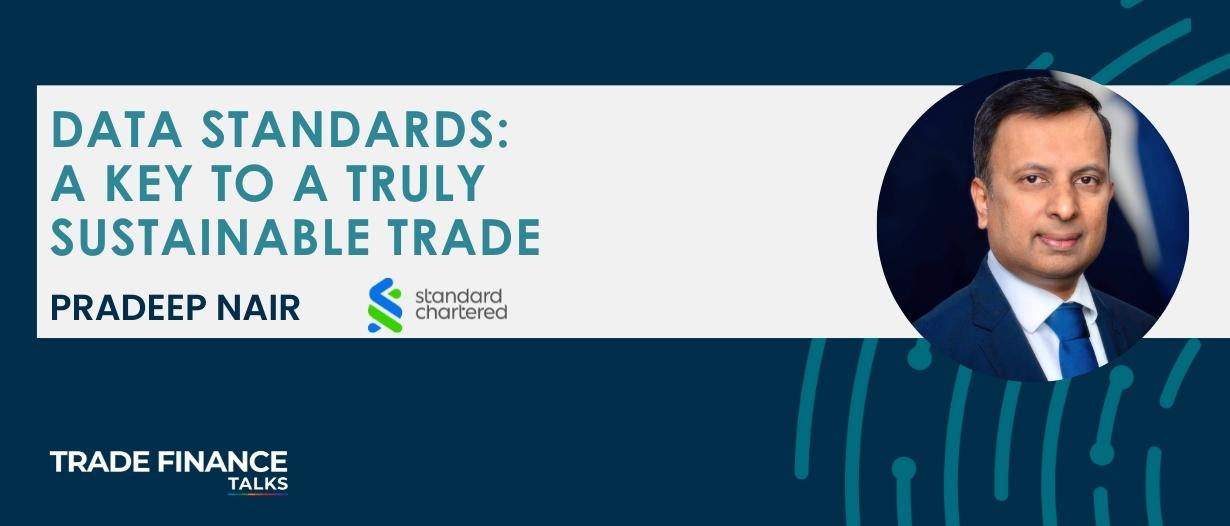For sustainable trade finance to scale, the industry needs a uniform model for ESG data that can be used by everybody.
Estimated reading time: 5 minutes
Companies around the world are almost unanimous in their desire to make their supply chains more responsible, resilient, and future-proof––no matter the sector or the region they operate in.
To better support them in their journey and for this to scale, however, the trade finance sector needs a universal framework for environmental, social, and governance (ESG) data.
Standard Chartered recently surveyed more than 500 C-suite and senior leaders as part of its Future of Trade 2030 report.
Its findings are encouraging: global trade is moving rapidly towards a new, more sustainable and inclusive paradigm.
However, although 9/10 of respondents acknowledged the need to incorporate ESG standards and practices across their supply chains, many do not have a clear view of what they need to do to achieve their goals.
The main reason for this is a lack of definitions around what ESG in trade actually is.

Lack of ESG clarity is a data problem
This is a data problem: there is no uniformity in either the inputs––that is, the metrics used or the data that need to be collected––or the outputs.
As a result, there’s no real way for companies to identify which areas they need to improve upon or benchmark themselves against others.
For banks looking to support their clients on the journey towards creating a more equitable, climate-sensitive, global trading system via sustainability-linked financing, this poses a serious challenge.
If a bank wishes to ascertain the credit risk of a client, it relies on ratings. While the output of each credit assessment, for example, BBB+, Baa1, or P2, depends on the model used, the inputs are governed by accounting standards, meaning they come from the same set of information.
The ESG landscape, in contrast, does not currently have any such uniform standards. Instead, there is a patchwork of different measures covering numerous sustainability metrics––some areas have no standards at all.
For carbon emissions, companies can use the GHG Protocol Corporate Standard, but while this covers the accounting and reporting of emissions, it does not provide granularity on how firms should conduct the verification process.
For other environmental and social issues in the supply chain, there are myriad areas to focus on. Each company at present has the freedom to effectively self-select the details that they believe to be material, leaving them open to claims of ‘greenwashing’.
Companies want to be able to understand their ESG risks and have conversations with their banking partners as to what solutions can be offered to mitigate them.
But with hundreds of different assessment techniques, scales, and ways of looking at ESG in trade––each capturing certain metrics and omitting others to give a red, amber, or green ESG score, or a rating of A or 1––every sustainability-linked trade and supply chain finance facility becomes a bespoke deal.
The lack of standards creates challenges for SMEs
This is fast becoming a major problem for SME suppliers, who should be the largest beneficiaries of sustainability-linked supply chain finance.
Often, a supplier may be catering to multiple buyers, each with different ESG criteria.
Without clear standards and an agreed-upon format, the amount of work that must go into acquiring the information required is significant, and this can create a barrier to accessing the financing that is needed.

A uniform model requires a collective effort
Through its sustainable trade proposition, Standard Chartered is aiming to address this confusing landscape.
Launched at the beginning of 2021, the proposition embeds measurable metrics that are aligned to external benchmarks across four pillars: sustainable goods, sustainable suppliers, sustainable end-use, and transition industries.
However, Standard Chartered cannot do this alone.
For sustainable trade finance to scale, the industry needs a uniform model that can be used by everybody.
This is why the International Chamber of Commerce’s (ICC’s) recent work has been welcomed; they have created the first-ever standardised assessment methodology to qualify the sustainability profile of trade transactions, industry-wide.
The opportunity is enormous. The rise of digitalisation in trade and the growing adoption of tools that can be leveraged for the attribution of ESG data at the transaction level are laying the ground for all participants in trade to collect and share information on their sustainability performance, allowing for meaningful change across supply chains globally.
But the data they share needs a framework.
This needs a home.
According to Standard Chartered’s research, global exports will rise from $17.4 trillion to $29.7 trillion over the next decade, with this upward trajectory bringing along new prospects for more inclusive, equitable growth.
An industry-wide model for ESG data will unlock the true power of trade as a force for good, as long as everyone adopts it.
Sources:
[1] Small business in the digital age focuses on a group of developing countries; see also VEEI studies on MSME resilience in the United States, Mexico, and Dubai, with studies for the United Kingdom and Poland to follow.
[2] According to KNOMAD / World Bank data accessed May 2022.
[3] Research conducted by East & Partners Europe, June 2019; Visa B2B Connect: Voice of the Customer – Banks Markets Report
[4] Ibid.
 Australia
Australia Hong Kong
Hong Kong Japan
Japan Singapore
Singapore United Arab Emirates
United Arab Emirates United States
United States France
France Germany
Germany Ireland
Ireland Netherlands
Netherlands United Kingdom
United Kingdom














Comments are closed.